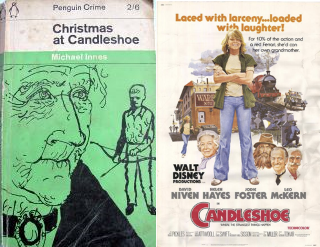Every once in a while, an adaptation is so loose that I cannot help wondering why it’s considered an adaptation at all. Now, I was initially excited to do this for the holidays, because I’d never read the book, and the title explicitly mentions Christmas. Then I read it, and Christmas is the surname of an artisan whose work is important to the story. So not only do we not get our plucky Jodie Foster character, we don’t have our holiday tie-in. The book has less to do with its adaptation than literally any other work we’ve done thus far.
The book is the story of two British families, the Scattergoods and the Candleshoes. The Scattergoods are better off but spring from a minor scion of the Candleshoe family. One day, Grant Feather and his mother are visiting Benison, the seat of the Scattergoods. They are wealthy Americans; Grant is studying at Oxford. His mother is halfheartedly looking for a stately English country house to buy, and after paying to take the tour of Benison, they end up at Candleshoe. The only ones living there are the extremely elderly Miss Candleshoe, the displaced in time chaplain Mr. Armigel, and the orphaned son of the late housekeeper, Jay Ray. Jay, the only one with any sense, makes it clear to Grant that there are criminals plotting to attack Candleshoe; Jay is holding them off along with a band of other local children, all armed with bows and arrows.
The movie, meanwhile, is the story of American foster child Casey Brown (Foster). One day, she is hauled off to London by Harry Bundage (Leo McKern) to participate in his current con—his cousin Clara Grimsworthy (Vivian Pickles) has discovered a clue to the hidden treasure of Captain Joshua St. Edmund, and if Casey can get accepted as the long-lost granddaughter of Lady St. Edmund (Helen Hayes), she can help find the treasure. It turns out that Lady St. Edmund is having money problems that are being hidden from her by her butler, Priory (David Niven), and the children she’s taken in from the local orphanage.
That is . . . two very different stories. So okay, Jay believes that Admiral Candleshoe, who died in 1597, was a pirate and left treasure, allegedly in an elaborate memorial to the admiral that’s in the Long Gallery of Candleshoe known as the Christmas box—as it was made by one Gerard Christmas. But there are no clues. The devious Bundage is replaced by a gang of possibly American gangsters hoping to steal a pair of Titians—which were initially stolen from Benison during World War II and are the subject of a complicated genealogical back story.
Actually, I’m glad I got around to reading the book. It’s fun enough. Grant’s bewilderment with the whole thing and frustration with his mother are relatable. The Scattergoods are completely believable for who and what they are. Mr. Armigel’s reference to the Boer War as “the war,” in the ’50s, is just one example of the utter disconnect he has from reality. Sometimes, the language is a little overblown, but it can also be good reading.
It’s just that I have no idea how we got from there to the treasure hunt of a plucky orphan with no sense of her own past. Candleshoe is one of my favourite movies, probably pretty consistently in my top ten. (My list changes a lot.) My sisters and I would get excited on those rare occasions when we’d see a commercial for it on The Disney Channel when we were little—and it was always the same commercial, with four different announcements that David Niven was in it because of the characters Priory plays. It was one of the first movies I bought on DVD, well before I picked up Freaky Friday.
Casey is clever. She’s not terribly learned; it’s clear that the system has failed her horribly over her life. Still, she’s got quick wits and is willing to learn what it takes to get what she’s looking for. It’s nice and wholesome and all that; she is working on how to love and trust and all that. I’m a little disappointed that the other kids don’t seem to have done much. Also, I have an idea for a sequel that would involve the actual inheritance issues of Candleshoe, because there’s no way heirs wouldn’t come out of the woodwork sooner or later.
Sure, okay, the villain of the movie is kind of . . . taxes. But taxing Lady St. Edmund literally out of her house, because she’s land-rich but has no apparent source of actual income, isn’t improving the British system as much as doing something about tax exiles or similar. There’s got to be a balance somewhere, so the stately homes are protected—it’s depressing what’s happened to them over the last fifty or so years—but the tax burden isn’t on people more like Priory. One assumes that Miss Candleshoe of the book would be homeless about six months after some of the taxes about to be passed.
It took real work to track down the book of this one; you can help out with future installments of the series by contributing to my Patreon or Ko-fi! And for next month, let’s go into the world of true crime with The Onion Field!

